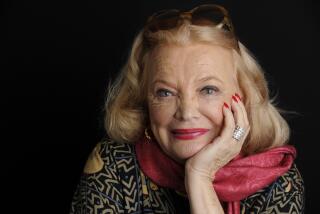A fresh breeze for ‘Wind’
- Share via
Despite winning two best actress Oscars -- for 1946’s “To Each His Own” and 1949’s “The Heiress” -- and appearing with Errol Flynn in some of the most acclaimed swashbucklers ever produced, including “The Adventures of Robin Hood,” Olivia de Havilland is best known for her indelible performance as the sweet, compassionate Melanie in the 1939 classic Civil War epic, “Gone With the Wind.”
But the process of getting cast in that role, for which she received her first Academy Award nomination, was almost as dramatic as the film itself, involving secret phone calls, clandestine auditions, covert meetings and heated negotiations.
De Havilland, who was just 22 at the time, had been put under seven-year contract to Warner Bros. studios in 1935 as a teenage ingenue. Studio chief Jack L. Warner rarely if ever lent out a star from his Burbank studio to a rival company. So when he learned that producer David O. Selznick and director George Cukor wanted her for the highly anticipated adaptation of the Margaret Mitchell bestseller, he initially refused to let his young star leave.
“The atmosphere was wonderful over at Selznick,” recalls De Havilland, who flew in recently from her home in Paris to talk about “Gone With the Wind,” which arrives Tuesday on DVD. “The atmosphere was not the same at the Warner lot. Jack really didn’t like actors at all and didn’t trust them. He liked writers, and I think he liked directors. So obviously that would create a different atmosphere. Selznick adored actors.”
The four-disc set from Warner Home Video features numerous bells and whistles, including an extensive interview with De Havilland, documentaries and audio commentary. The Oscar-winning blockbuster, which stars Vivien Leigh as the Southern vixen Scarlett O’Hara, Clark Gable as the dashing Rhett Butler and Leslie Howard as Melanie’s weak-willed husband Ashley, has been digitally restored in what Warner calls its “Ultra-Resolution” process, and the set features a look at the special restoration process.
Of the four main stars of “Gone With the Wind,” De Havilland is the only survivor -- Howard died in 1943, Gable in 1960 and Leigh in 1967. Sitting in a small suite at the Four Seasons, de Havilland looks every inch a grande dame -- her white hair is perfectly coiffed and she’s wearing a stylish black dress and expensive white pearls.
But looks can be deceiving. She admits a nun who taught her in Catholic girls’ school long ago referred to her as a “brass monkey” because she would always get herself into trouble. Even eight decades later, De Havilland still has a bit of the brass monkey in her. She has a hearty, infectious laugh, which no one would ever describe as ladylike. There is a devilish twinkle in her brown eyes. She also gasps in mock embarrassment when she realizes she has a run in her stockings.
Her participation in “Gone With the Wind,” she says, began when she received a call from Cukor. One of the top directors in Hollywood, Cukor was under contract to Culver City-based MGM. “Culver City is very far from Burbank,” she says. “It is two different nations. I had never met anybody at MGM.”
De Havilland was excited by the prospect of playing Melanie, whom Scarlett referred to as a “namby-pamby” but in reality was anything but. If Warner found out that Cukor had contacted De Havilland first, though, it would have led to lawsuits for the director, Selznick and even De Havilland.
“He said, ‘Well, I’m going to suggest something to you which is entirely illegal. Would you come over to Selznick studios and read for the part?’ He said tell no one, absolutely no one. I went to a secret entrance and they were waiting for me at the appointed time. They unlocked the door to the entrance and let me in to George’s office.”
After she’d read two scenes for Cukor, the director called Selznick and suggested the three meet. “It was all arranged that I would meet David at 3 at his house with George, and I was to commit the scene to memory. It was a scene with Melanie and Scarlett.”
During the audition for Selznick, Cukor took the role of Scarlett. Selznick, she says, “studied us with great intensity and when he finished the scene, he said, ‘I think we found our Melanie.’ ”
When Warner turned a deaf ear to Selznick and Cukor’s pleas to lend her to them, De Havilland made an appointment to see Warner, but she had no luck budging the mogul.
“So I called up Mrs. Warner and asked her to have tea with me,” De Havilland recalls. “She agreed and I told her how much the part meant to me. She had been an actress before she married Jack. She said, ‘I understand how you feel and I will try to help you.’ She was the one who persuaded Jack to let me go.”
More to Read
Only good movies
Get the Indie Focus newsletter, Mark Olsen's weekly guide to the world of cinema.
You may occasionally receive promotional content from the Los Angeles Times.











